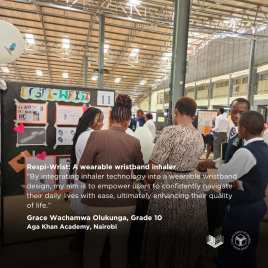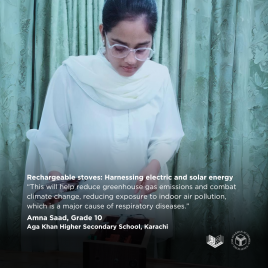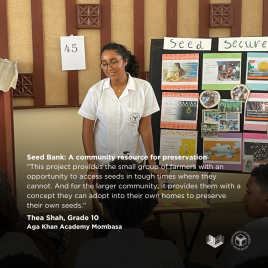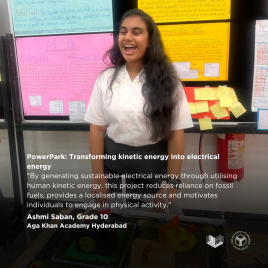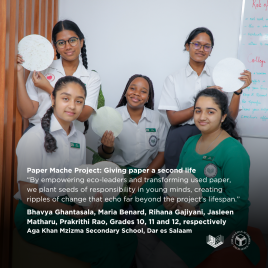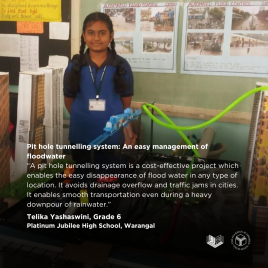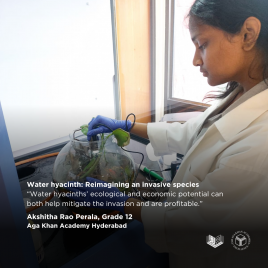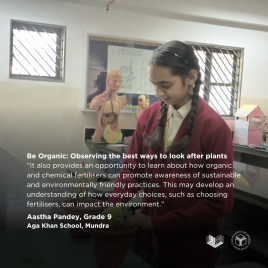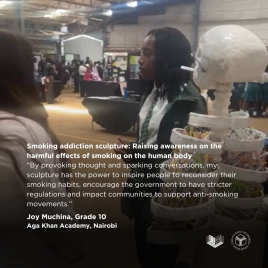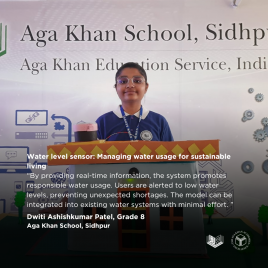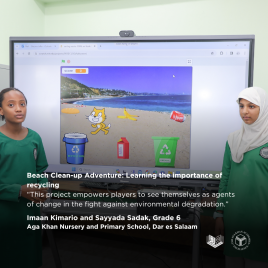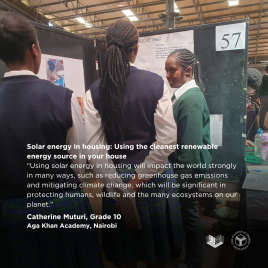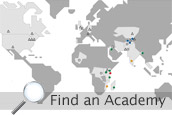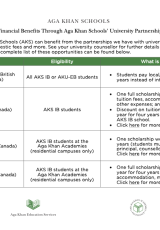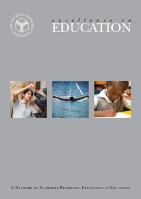Aga Khan Schools celebrates International Day of Women and Girls in Science
Every year, International Day of Women and Girls in Science is celebrated on 11 February highlighting the critical role women and girls play in science, technology, engineering and mathematics (STEM). This year, the Aga Khan Schools is recognising some of its extraordinary students and their innovative science projects. Read about these students below.
Grace Wachamwa Olukunga, Aga Khan Academy, Nairobi
Grade 10 student Grace Wachamwa Olukunga offers a discreet and portable solution for managing asthmatic symptoms with the inventive and creative “Respi-Wrist”.
Describe your project.
“My project is titled the ‘Respi-Wrist’. This is based on the accessibility and convenience of inhaler technology by integrating it into a wearable wristband. This innovative idea combines functionality and fashion.”
“Through the use of 3D printing and designing, I have been able to make two physical prototypes that are basically tangible demonstrations of how the device will administer its medicine. These prototypes aim to showcase the basics of the inhaler’s functionality, together with the wristband factor, emphasising the depth of its ease of use and comfort for individuals with rigorous asthmatic symptoms.”
How will this impact the world?
“The ‘Respi-Wrist’ project has the potential to transform the landscape of respiratory care by providing a discreet, accessible and convenient solution for individuals managing respiratory conditions. By integrating inhaler technology into a wearable wristband design, my aim is to empower users to confidently navigate their daily lives with ease, ultimately enhancing their quality of life.”
“Furthermore, by re-imaging the inhaler design into a wearable and reusable solution, I will reduce the need for disposing plastic inhaler packaging and promote long-term usage. This will minimise the environmental impact while maximising respiratory health benefits for users worldwide.”
Amna Saad, Aga Khan Higher Secondary School, Karachi
Grade 11 student Amna Saad has developed a rechargeable stove, which will provide an innovative and sustainable solution to air pollution from stoves that use natural gas.
Describe your project.
“Rechargeable stoves operate by harnessing the energy stored in rechargeable batteries and utilising aluminium as their heating component. These stoves can be recharged using either solar panels or mains electricity as their power source.”
How will this impact the world?
“The use of rechargeable stoves will reduce the dependency on traditional fuels like natural gas, wood, charcoal and kerosene. Also, this will help reduce greenhouse gas emissions and combat climate change, reducing exposure to indoor air pollution which is a major cause of respiratory diseases. In addition, rechargeable stoves are convenient for power breakdowns and gas cut-offs as they can be easily charged on solar panels.”
“Moreover, in the world of electric stoves, nickel-chromium demands a hefty toll of electricity and induction cook-tops are quite expensive. However, aluminium emerges as the humble hero, offering efficiency, affordability and sustainability, transforming the landscape of energy consumption.”
Thea Shah, Aga Khan Academy Mombasa
Thea Shah, a Grade 10 student, contributes to the new era of sustainability by creating the project “Seed Bank” for local farmers and the wider community.
Describe your project.
“I learnt through research with local experts about traditional methods of preserving seeds through using a seed bank. After challenges with the initial community I was working with, I decided to work with a group of 15 female farmers from a village in Kikambala who provide food for their families, who cook food for their family and who often have a more silent voice in their village settings.”
“A seed bank is a community resource that is used for storing seeds for the long run within a community. It works like a bank, except without money, so it includes different containers of different types of seeds, which I organised into three columns in terms of the seasons of consumption. The farmers deposit their own seeds and keep track using a register, they can withdraw their seeds or another farmer’s seeds when they need.”
“Another thing I did for my project was creating leaflets which I spread across restaurants, workspaces and hotels across Mombasa, where I emphasised the importance of preserving seeds and traditional methods of doing so that they can do in their homes.”
How will this impact the world?
“This project is important because it gives me the joy of helping others who help us every day by providing us with food. While this is true, this project is more important to the larger community; not just to the farmers, but possibly to most of the citizens of Mombasa who have learnt about and engaged with my project.
“This project provides the small group of farmers with an opportunity to access seeds in tough times where they cannot. And for the larger community, it provides them with a concept they can adopt into their own homes to preserve their own seeds.”
Ashmi Saban, Aga Khan Academy Hyderabad
Grade 10 student Ashmi Saban’s creative innovation imagines a park that turns kinetic energy into electrical energy.
Describe your project.
“My science project titled ‘PowerPark’ is a children’s park prototype that features innovative technologies such as piezoelectric tiles, standing cycles, an energy capturing seesaw and a merry-go-round, which are successful in harnessing human kinetic energy and transforming it into electric energy.”
“If implemented in real life, ‘PowerPark’ can generate an astonishing 1023.40 (approximately) kilowatts every week. Not only is this park energy efficient, but it is highly cost-effective, saving INR 393,134.70, or USD 4,735.41 (following the current rates of electricity in the US), considering the increase in the electricity rates due to several factors including depletion of fossil fuels and population growth.”
How will this project impact the world?
“This project has the potential to address three major issues faced by the world today, including climate change, the energy crisis and physical inactivity among individuals, particularly adolescents. By generating sustainable electrical energy through utilising human kinetic energy, this project reduces reliance on fossil fuels, provides a localised energy source and motivates individuals to engage in physical activity.”
Bhavya Ghantashala, Maria Benard, Rihana Gajiyani, Jasleen Matharu, Prakrithi Rao, Aga Khan Mzizima Secondary School, Dar es Salaam
Grade 10, 11 and 12 students teamed up to tackle the mountains of used paper accumulating at school and turn them into fresh and usable sheets.
Describe your project.
“This project gives paper a second life by reducing waste, conserving resources and promoting responsible paper use. Seeing the potential for a broader impact, we trained as eco-leaders to advocate for our paper recycling project.”
“Together, we are raising awareness and tackling waste head-on! Currently, our mission is to create 150 recycled paper sheets for a special Valentine's Day activity with the young students at the Aga Khan Nursery and Primary School, Dar es Salaam. This project goes beyond crafting paper; it is about fostering eco-consciousness in young minds and inspiring future environmental leaders.”
How will this impact the world?
“This project is not just about recycled sheets; it is about weaving a legacy of environmental stewardship. Each sheet whispers a story of conservation, turning waste into a tapestry of purpose. By empowering eco-leaders and transforming used paper, we plant seeds of responsibility in young minds, creating ripples of change that echo far beyond the project's lifespan.”
Telika Yashawini, Platinum Jubilee High School, Warangal
Grade 6 student Telika Yashaswini’s invention of a pit hole tunnelling system allows the easy management of floodwater. She even won first place in the 51st Rashtriya Bal Vaigyanik Pradarshani (RBVP) District Science Fair!
Describe your project.
“Every year, we face floods across several places in our country. Due to heavy downpour, our places get flooded and become stagnant, which leads to traffic jams, transportation problems for the delivery of essential commodities, eruption of water borne diseases, foul smell, contamination of ground water, destruction of the agricultural crops, etc. Though some places have flood water canals, it is not up to the mark to overcome the damage caused due to the floods.”
“Based on my observations from several sources, namely newspapers, television, internet, magazines and live observation of the flood affected areas during my travel, I found that the process of diverting floodwaters poses significant challenges and it is a time taking strategy which involves a lot of manpower and expenditure. As per my research and analysis, I suggest that we can construct a pit hole tunnelling system in the affected areas like traffic junctions, agricultural fields, residential colonies, etc. to discharge the flood water within minutes.”
How will this impact the world?
“A pit hole tunnelling system is a cost-effective project which enables easy disappearance of flood water in any type of location. It avoids drainage overflow and traffic jams in cities. It enables smooth transportation even during heavy downpour of rainwater. It prevents the contamination of ground water as in the case of drainage canals. There is no chance of the emission of any foul smell. It does not act as a reservoir to any type of water or airborne diseases. It enables an increase in the ground water level. A pit hole tunnelling system provides instant relief from the flooding of rainwater in cities as well as in the agricultural fields if it is implemented.”
Akshitha Rao Perala, Aga Khan Academy Hyderabad
Akshitha Rao Perala, a Grade 12 (Diploma Programme 2) student, thought of a creative solution to tackle harmful pollutants in aquatic environments using water hyacinth.
Describe your project.
“My extended essay focuses on the impacts of invasive species in ecological and socio-economic aspects. I particularly chose water hyacinth, because it is one of the 10 most invasive species in the world and has affected the lakes of Hyderabad, which is where I live. Interestingly, in the quest of understanding the problem, I found a simple-yet-brilliant solution. Most research papers and articles gave me insights into the negative implications of water hyacinth on ecology, such as pH alteration, reduction of dissolved oxygen in water bodies which leads to the asphyxiation of aquatic plants and fish, socio-economic implications like the losses incurred to fisherman, and the inhospitable living conditions for the families living around lakes. However, I have researched into the potential of water hyacinth as a natural and positive resource.”
“The qualities of water hyacinth, like phytoremediation, absorbs harmful pollutants in aquatic environments. Phytoremediation, combined with water hyacinth's buoyancy, makes it ideal to build a floating treatment wetland, small artificial islands in which aquatic plants can grow in water that might typically be too deep for them, to help restore urban lakes. Its nutrient composition makes it an effective compost rich in nitrogen, phosphorus and potassium, proving to be four times richer than farmyard manure.”
“Water hyacinths’ ecological and economic potential can both help mitigate the invasion and are profitable.”
How will this impact the world?
“The invasion of water hyacinth is one of the most challenging environmental issues of Hyderabad’s lakes. The Government of Telangana initiated projects with an estimated cost of 31 crores (over USD 3 million). However, this cannot completely solve the invasion as it is a recurring problem. The existing strategies for mitigation, including physical methods like cutting, hand-pulling and the use of weed harvesters, are found to be fraught with drawbacks such as increased restoration costs, environmental impact and non-targeted habitat disruption.”
“Additionally, chemical methods involving Bispyribac, Diquat and Glyphosate present their own set of challenges, ranging from efficacy issues to environmental persistence. The biological approach, while environmentally friendly, faces hurdles in adapting to smaller, man-made environments like Hyderabad’s lakes and their interconnected food webs.”
“Thus, comprehensive research to innovate mitigation solutions, that has an integrated approach of both the removal methods and resource utilisation, is essential to tackle the invasion of water hyacinth in Hyderabad’s lakes.”
Aastha Pandey, Aga Khan School, Mundra
Grade 9 student Aastha Pandey’s experiment with fertilisers reveals the difference between chemical and organic compounds and the best way to provide plants with essential nutrients.
Describe your project.
“This research aimed to compare the effects of different fertilisers on Clivia plants, focusing on growth, density and flowering pattern. Five of the same aged Clivia plants were subjected to various fertilisers (urea, NPK, manure, kitchen waste), while a control was planted in garden soil. After 15 days, it was observed that NPK-treated plants displayed less flowering with lower density, urea-treated plants experienced desiccation and death, kitchen waste-treated plants exhibited abundant flowering and high growth density, and manure-treated plants showed moderate flowering but dense growth.”
How will this impact the world?
“The experiment introduces gardening skill concepts, teaching about plant growth, nutrient requirements and the effects of different fertilisers and the mindful use of fertilisers. It also provides an opportunity to learn about how organic and chemical fertilisers can promote awareness of sustainable and environmentally friendly practices. This may develop an understanding of how everyday choices, such as choosing fertilisers, can impact the environment.”
“Additionally, the experiment may instil a sense of environmental responsibility by highlighting the potential negative effects of certain fertilisers. People can start considering the ethical aspects of choices related to agriculture, gardening and environmental practices. Lastly, this experiment can inculcate an understanding of the reuse of organic kitchen waste that is generally thrown as trash which can be used in a sustainable manner.”
Joy Muchina, Aga Khan Academy, Nairobi
Grade 10 student Joy Muchina educates the youth in the community about the harmful effects of smoking on the human body.
Describe your project.
“My personal project is creating a sculpture inspired by the smoking addiction in the community to educate the youth around me about the dangers of smoking. My learning goal is to learn how to sculpt because, although I am an art student, I have never delved into the art of sculpting, and I thought it would be an interesting way to challenge myself. My product goal is a sculpture representing smoking addiction.”
How will this impact the world?
“This sculpture has the potential to raise awareness about a pressing issue that continues to be over-glorified. By provoking thought and sparking conversations, my sculpture has the power to inspire people to reconsider their smoking habits, encourage the government to have stricter regulations and impact communities to support anti-smoking movements. Ultimately, the sculpture has the capability to contribute towards a healthier, smoke-free world one person at a time.”
Dwiti Ashishkumar Patel, Aga Khan School, Sidhpur
Grade 8 student Dwiti Ashishkumar Patel’s innovation aims to manage water usage for sustainable living.
Describe your project.
“Water is a precious resource, and managing its usage is crucial for sustainable living. In many households, water wastage and scarcity are significant concerns. The water level detecting model aims to tackle these issues by providing real-time monitoring and alerts. The water level sensor is strategically placed in the water source, whether it's a tank, well or a reservoir.”
“The data is processed to determine the current water level. Red LED indicates a low water level, signalling the need for water conservation. Yellow LED warns of a moderate water level, prompting users to be mindful of consumption. Green LED signals an optimal water level, ensuring efficient usage.”
“The system can be expanded to include alert mechanisms, such as SMS notifications or alarms, for critical water levels.”
How will this impact the world?
“By providing real-time information, the system promotes responsible water usage. Users are alerted to low water levels, preventing unexpected shortages. The model can be integrated into existing water systems with minimal effort.”
“By providing real-time data and alerts, this system empowers users to make informed decisions for a sustainable future.”
Imaan Kimario and Sayyada Sadak, Aga Khan Nursery and Primary School, Dar es Salaam
Grade 6 students Imaan Kimario and Sayyada Sadak collaborated on a sustainability-focused project through coding a game.
Describe your project.
“In this game called ‘Beach Clean-up Adventure’, players navigate a beach scene, tackling land pollution. They are guided by a dog to collect recyclable materials, such as soda cans and milk boxes, which are then disposed of in a recycling bin. Additionally, players collect banana peels and bread, which are added to the organic bin for composting.”
How will this impact the world?
“This project empowers players to see themselves as agents of change in the fight against environmental degradation. By combining fun gameplay with educational messages, we are fostering a generation of eco-conscious individuals who understand their role in creating a sustainable future."
Catherine Muturi, Aga Khan Academy, Nairobi
Catherine Muturi, a Grade 10 student, raises the importance of switching to solar energy in housing with her project.
Describe your project.
“My science project was on solar energy in housing. It dealt with bringing awareness on the great importance of switching to solar energy in housing as solar energy is known to be the cleanest renewable energy source our planet has. Solar energy comes from the sun so using it as a main source of energy instead of other harmful sources is a huge benefit in maintaining our planets environment.”
How will this impact the world?
“Using solar energy in housing will impact the world strongly in many ways, such as reducing greenhouse gas emissions and mitigating climate change which will be significant in protecting humans, wildlife and the many ecosystems in our planet.”

